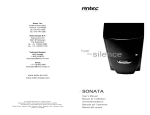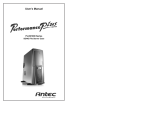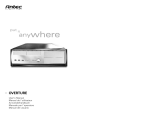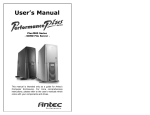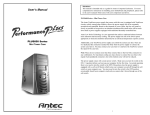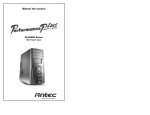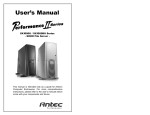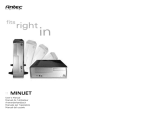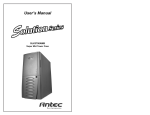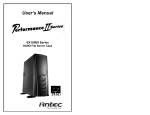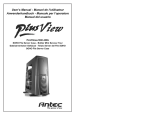Download User's Manual Manuel de l'utilisateur Anwenderhandbuch
Transcript
User’s Manual Manuel de l’utilisateur Anwenderhandbuch Manuale per l’operatore Manual del usuario Table of Contents - Table des matières Inhaltsverzeichnis - Índice - Indice English................................................... 1 Français................................................. 9 Deutsch................................................. 19 Italiano.................................................. 29 Español................................................... 39 The high quality of our products is assured by a continuous process of refinement of their technical features. Therefore, it is possible that your product may differ in some respect from the descriptions contained in this manual. This is not a problem – it is an improvement. All features, descriptions and illustrations contained herein are valid as of the date of publication. Disclaimer This manual is intended only as a guide for Antec's Computer Enclosures. For more comprehensive instructions on installing your motherboard and peripherals, please refer to the user's manuals which come with your components and drives. SONATA User's Manual The Antec TruePower power supply that comes with this LifeStyle series case is equipped with Antec Low Noise Technology circuitry. Antec Low Noise Technology is an advanced approach that achieves optimum balance between noise reduction and necessary cooling. The power supply fans run at the lowest speed appropriate to load and conditions as determined by a temperature response system which outperforms previous designs. This keeps power supply noise at a minimum and overall noise will be much lower than in cases equipped with traditional power supplies. Additionally, your TruePower power supply can control the system case fans. There are two dedicated fan connectors marked Fan Only from the power supply to connect the system case fans to. You may connect your case fans to it and have the TruePower control the speed of the case fans, further reducing total noise. IMPORTANT MESSAGE - PLEASE READ BEFORE USING: The Sonata is engineered to maximize your computing experience while minimizing the noise in your environment. To minimize system noise in the majority of computing configurations, Antec suggests that you connect your case fans using the "Fan Only" connectors. However, if you plan to use your computer system in high performance, heat generating configurations (such as overclocking, intense gaming, etc.) Antec strongly recommends that you connect your system fans to the standard connectors, NOT to the fan only connectors, as this will maximize your system's cooling capability and prevent overheating. Note: Please do not connect more than three fans to the Fan Only connectors in any combination. For maximum cooling you may choose to connect the case fans to the regular 4-pin peripheral connectors, but in this fashion noise will not be reduced. The power supply comes with a main power switch. Make sure you turn the switch to the ON ( I ) position before you boot up your computer for the first time. In normal operation there is no need to turn the switch to the OFF (O) position since the power supply is equipped with a soft on/off feature which turns your computer on and off through the soft switch on your computer case. You may need to turn the switch to the OFF position occasionally should your 1 computer crash and you cannot shut it down through use of the soft switch. [Applicable ONLY to models designed for sale in the European Union: TruePower models designed for the EU include Power Factor Correction (PFC) circuitry in accord with European standard regulation code EN61000-3-2. By altering the input current wave shape, PFC improves the power factor of the power supply and results in increased energy efficiency, reduced heat loss, prolonged life for power distribution and consumption equipment, and improved output voltage stability.] Set 1. 2. 3. Up Take the case out of the box. Remove the Styrofoam and plastic bag. Place the case upright with the power supply fan at the back facing you. (Note: NOT applicable to models designed for the European Union.) Check the red power supply voltage switch setting. It should be the same as your local power voltage (115V for North America, Japan, etc. and 230V for Europe and many other countries). Change the voltage setting if necessary. Failure to take this precaution could result in damage to your equipment and could void your warranty. 4. Remove the screws from the panel with the latch. Unlock the side panel, swing the panel out, and remove it. Set the panel safely aside. Note: Please don't try to use your fingernails to pry or lift the panel. 5. Inside the case you should see the power supply, some wiring with marked connectors (USB, PWR etc.), an installed I/O panel and a power cord. You will also find a bag of hardware (screws, brass standoffs, plastic stands, etc.). 6. To remove the front bezel door, open the door no more than 90º, and gently press the small plastic tab at the upper hinge. Tilt the door away from the upper hinge pin, then lift it off the lower hinge pin. Set the door aside in a safe place. To replace the front bezel door, place the lower hinge slot over the lower hinge pin and press or rotate the top of the door in so that the tab fully engages with the upper hinge pin. Motherboard Installation This manual is not designed to cover CPU, RAM, or expansion card installation. Please consult your motherboard manual for specific mounting instructions and troubleshooting. 1. 2. 3. 4. 5. Lay the case down so that the open side is up. You should be able to see the drive cage and power supply. Make sure you have the appropriate I/O panel for your motherboard. If the panel provided is not suitable for your motherboard, please contact your motherboard manufacturer for the correct I/O panel. Line up your motherboard with the standoff holes, and determine which ones line up and remember where they are. Not all motherboards will match with all of the provided screw holes, and this is not necessary for proper functionality. (In other words there will likely be extra holes.) Some standoffs may be pre-installed for your convenience. Lift up and remove your motherboard. Screw in the brass standoffs to the threaded holes that line up with your motherboard. 2 6. Place your motherboard on the brass standoffs. 3. 7. Screw in your motherboard to the standoffs with the provided Phillipshead screws. Your motherboard is now installed. 4. Power/LED Connections The Antec TruePower supply is an ATX12V form factor power supply. An ATX12V power supply has a single 20-pin Main Power Connector, a 6-pin AUX Power Connector and a 4-pin +12V Power Connector to connect to the motherboard. It also comes with five to seven 4-pin Peripheral Power Connectors and two or three 4-pin Floppy Drive Power Connectors for your drives. It is backwards compatible to previous ATX formfactor power supplies. If your motherboard does not support the AUX Power Connector or the+12V Power Connector, you can still use this power supply. The power supply is also equipped with a 3-pin fan signal connector. Connect it to one of the fan connectors on your motherboard. You may monitor the speed of the rear power supply fan through your motherboard BIOS or through the monitoring software that comes with your motherboard. Note: The speed of the fan may be as low as 1500 RPM when temperatures are low. At these speeds some motherboards may not be able to properly detect the fan speed and may generate false warnings of fan failure. Please refer to your motherboard manual for proper fan monitoring set up. 1. 2. 3. 4. 5. Connect the 20-pin ATX power connector (and AUX or +12V connectors if appropriate) to your motherboard. The Reset switch (labeled RESET SW) connects to your motherboard at the RST connector. The colored wire should be attached to Pin 1 and the black wire to ground. This applies for all of the following connectors as well. Power Switch (labeled POWER SW) connects to the PWR connector on the motherboard. The Speaker, Power LED and Hard Drive LED connectors share a single ribbon cable. Attach the Speaker (labeled SPEAKER), Power LED (labeled POWER) and HDD LED connectors to the appropriate headers on your motherboard. The front panel of this case comes with two decorative blue LEDs beside the flip door concealing the front USB/FireWire connectors. Locate the Molex 4-pin male connector from the bezel and connect it to a 4-pin connector from the power supply. The LEDs will light when you power the system. USB Connections There are 8 wires with connectors coming out from the front mounted USB ports of the case. 1. 2. Locate the internal USB header on your motherboard. It consists of 10 pins in two rows. Note: On some motherboards one or two pins may be marked as NC. This indicates no contact. It is an empty pin. You don't need to use it. On some motherboards one pin may be missing on either one or both rows. Don't worry about it. You only need to connect to 8 pins. Consult your motherboard manual to get each of the pin-out positions. 3 5. Power Pins: There are two power pins, one on each row. They are usually marked as Power, Vcc or +5V. Connect the two +5V connectors to the two power pins. Each connector can go to either pin. Ground Pins: There are two ground pins, one on each row. They are usually marked as GROUND or GND. Connect the two GROUND connectors to the two ground pins. Each connector can go to either pin. Note: On some motherboards, there may be two ground pins on one row. You don't need to use all of them. Make sure to connect one ground pin on each row. Data Pins: There are two plus data pins, one on each row, and two minus data pins, one on each row. They are usually marked as USBD2+, USBD3+ and USBD2-, USBD3- or USBP2+, USBP3+ and USBP2-, USBP3- respectively. a. Connect the (1)+D connector to any of the two plus data pins. It can go to either of the plus pins. b. Connect the (1)-D connector to the minus data pin in the same row with the plus data pin that (1)+D connector has just connected to. c. Repeat the same procedures to connect the (2)+D and (2)-D to the motherboard. Make sure they are in the same row. IEEE 1394 (FireWire, I-Link) Connection There are six wires with connectors coming out from the front-mounted IEEE 1394 port of your case. They consist of 2 sets of twisted pair cables; TPA (Twisted Pair A) and TPB (Twisted Pair B), a power cable (VP), and a ground cable (VG). 1. 2. 3. 4. Locate and identify the pin-out of the IEEE1394 port on your motherboard. Power Pin: Connect the VP connector to it. Ground Pin: Connect the VG connector to it. Data Pins: There are two sets of data pins. Each set consists of a plus and a minus pin. They are usually marked as TPA+ and TPA-, TPB+ and TPB-. a. Connect the TPA+ connector to the TPA+ data pin and TPAconnector to the TPA- data pin. b. Connect the TPB+ connector to the TPB+ data pin and TPBconnector to the TPB- data pin. Audio Connections There is an Intel standard 10-pin connector (with also 7 individual wires with individual connectors) attached to a gray wire leading from the front panel speaker and microphone connectors. If your motherboard supports Intel's standard onboard audio connector, you can plug the 10-pin connector directly onto the board. For non-Intel standard audio connections, you will need to plug the 7 individual connectors into the motherboard. Instructions for non-standard audio connections 1. Locate the internal audio connectors from your motherboard or sound card. 2. Consult your motherboard or sound card manual for the pin-out positions. 3. Microphone Power Pin: Connect the MIC connector to this pin. 4. Microphone Input Pin: Connect the MIC-BIAS connector to this pin. 5. Ground Pin: Connect the AUD GND connector to this pin. 6. Front Right Speaker Out Pin: Connect the FPOUT-R connector to this pin. 4 7. 8. 9. Front Left Speaker Out Pin: Connect the FPOUT-L connector to this pin. Rear Right Speaker Out Pin: Connect the RET-R connector to this pin. Rear Left Speaker Out Pin: Connect RET-L connector to this pin Note: Your motherboard may not support rear speaker output. In this case, you do not need to connect RET-R and RET-L. 4-pin connector on each of the devices. Data Cable Connection After you have connected the devices to the power supply, you need to connect the data cables between the devices and the motherboard. The data cables are not included with the case; we include this information only as an aid. 3.5" Device Installation There are two external 3.5" drive bays right under the 5.25" drive bays. Press the two metal tabs on the sides of the 3.5" drive tray and pull the 3.5" drive tray out of the case. You may wish to remove the bezel door to facilitate this. 1. 1. 2. 2. 3. 4. Remove the drive bay cover from the drive bay that you intend to install the drive. Mount your floppy drive or other external device into the drive bay. Repeat the same procedure for the other drive as necessary. Slide and lock the drive tray back into the case. Find a small 4-pin white power connector on the power supply and connect it to the male 4-pin connector on the device. There are 4 internal drive bays right under the external 3.5 drive bays for hard drives. Each comes with an individual drive tray which mounts through the open side panel of the case. 1. 2. 3. 4. 5. Squeeze the metal clips on each side of the tray and slide the tray out. Mount your hard drive or other internal 3.5" device into the drive tray through the bottom rubber grommets with the special screws provided. Don't over-tighten. Over-tightening the screws will harm the vibration and noise reducing ability of the rubber grommets. Slide and lock the tray back into the case. Find a 4-pin white molex connector on the power supply and connect it to the male 4-pin connector on the device. Repeat the same procedure for the other drives as necessary. Note: You can mount the drives with either the connectors facing you or away from you. If you mount them with the connectors facing away from you (into the case) you may wish to connect the data cables before sliding the drive into the locked position. Note: Mounting the drives with the connectors facing you (towards the open side of the case) may make squeezing the release clips more difficult. 5.25" Device Installation There are three 5.25" drive bays. Each drive bay comes with a plastic cover with two drive rails attached behind the cover. 1. 2. 3. 4. 5. Remove the plastic drive bay cover and remover the drive rails from the cover. You may wish to remove the bezel door to facilitate this. Mount the drive rails onto the sides of the 5.25" device. Make sure the metal portion is angled on the outside and facing towards the front of the device. Slide the device into the drive bay until you hear a click. Mount the other devices accordingly. Connect a large 4-pin white connector from the power supply to the male 5 3. For hard drives and CD-ROM's, use the 40-pin IDE ribbon cables. For floppy drives, use the 34-pin ribbon cables. These should come with your devices and have a red strip on one side indicating pin number 1. When you connect a ribbon cable to a device, make sure that the red strip is on pin 1, usually toward the power connector. The side that attaches to devices should be the side that has 2 connectors. This will enable you to connect another device if you wish. Connect the far end of the cable to your motherboard on the IDE port, either IDE 1 or IDE 2, or the FLOPPY port. NOTE: If you wish to connect a 3.5" drive and a 5.25" drive on the same IDE channel, we recommend that you use IDE cables which provide 10 or more inches of flexible cable between connectors or the start of any protective boot. We further recommend that you mount the drives such that the 3.5" drive is in the topmost internal 3.5" bay and that the 5.25" drive is in the bottom 5.25" bay Fan Installation The case has one 120mm cooling fan mounted in the rear with vibration reducing rubber grommets, and one optional 120mm cooling fan mount in the front right behind the 3.5" internal drive bays. The rear fan is installed so that the air is blowing out of the case. Connect a 4-pin connector from the power supply to the connector on the fan. We recommend connecting the fan to TruePower's Fan Only connector so that Low Noise Technology can control the RPM of the fan according to the temperature changes within the case. The front fan should be installed so that the air is being pulled into the case from the front. We recommend NOT installing the optional fan unless necessary for cooling, since it will create additional fan noise. However if you do wish to install the front fan, please install the fan before you install the internal drives. Washable Air Filter Maintenance There is a washable air filter behind the front bezel, accessable from below. To remove, tilt the case backwards so you can use your fingers to squeeze the two tabs on the filter to remove it. We recommend washing the air filter as often as required by environmental conditions, at least once a month initially. Failure to keep the installed air filter clean will result in higher system temperatures and possible system stability problems. Antec Quality 3-Year parts and labor warranty See details at: http://www.antec-inc.com/warranty.html 6 SONATA Piano Black Super Mini Tower Drawing Number 1 2 3 4 5 6 7 8 9 10 11 12 13 14 Description Handle Side Panel Top Panel Front Panel 3.5" Drive Cover Front Port Cover Lower Front Panel Front Door 5.25" Drive Cover 5.25" Drive Rails 3.5" Drive Cage Washable Air Filter 3.5" Internal Drive Tray 120mm Fan Mount






